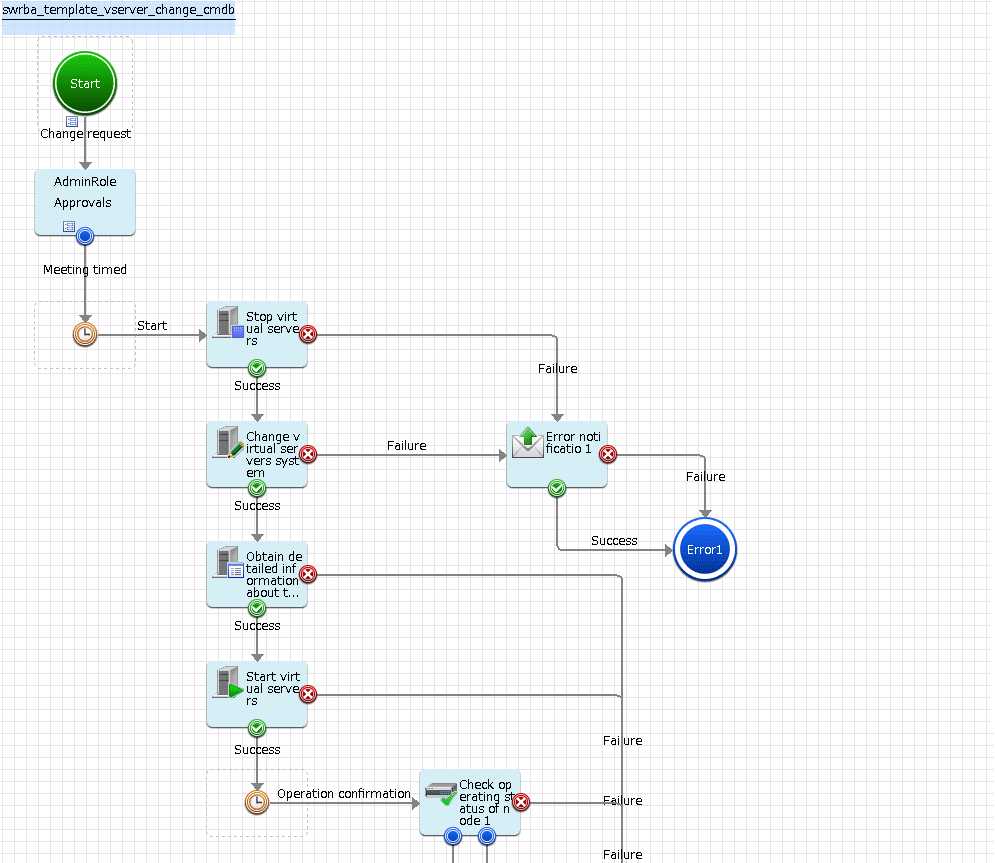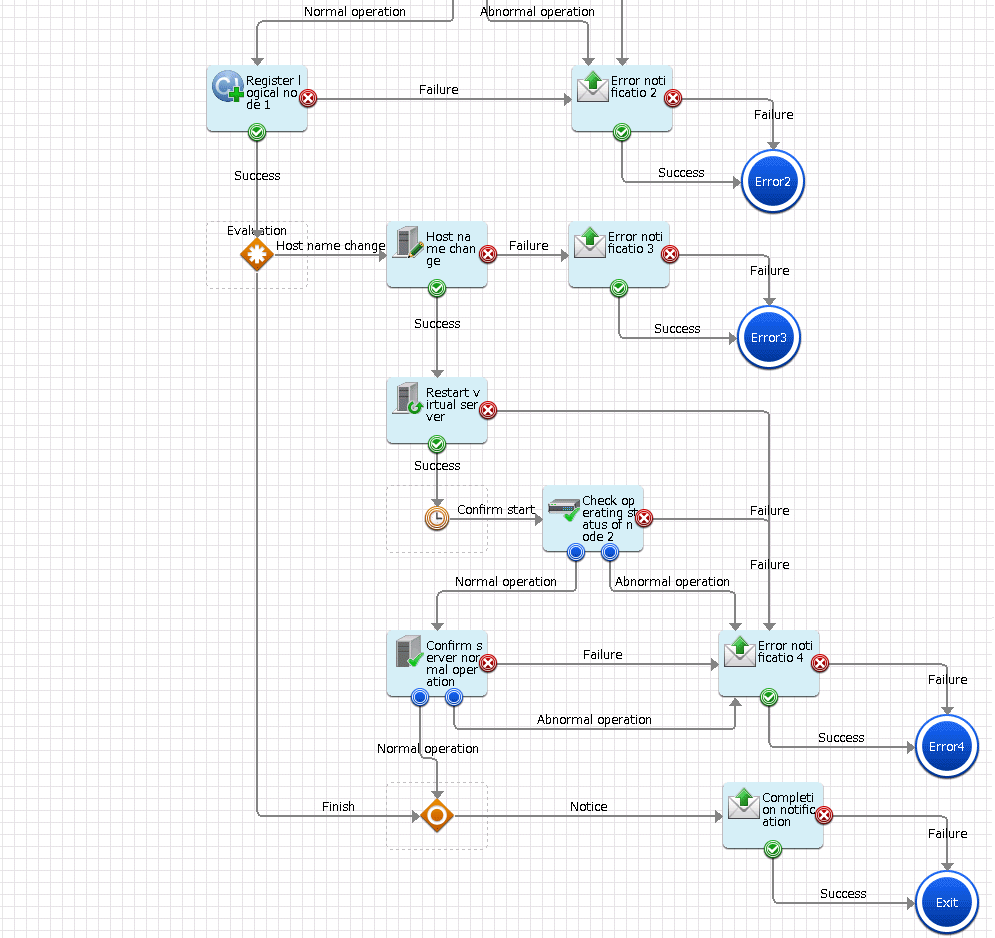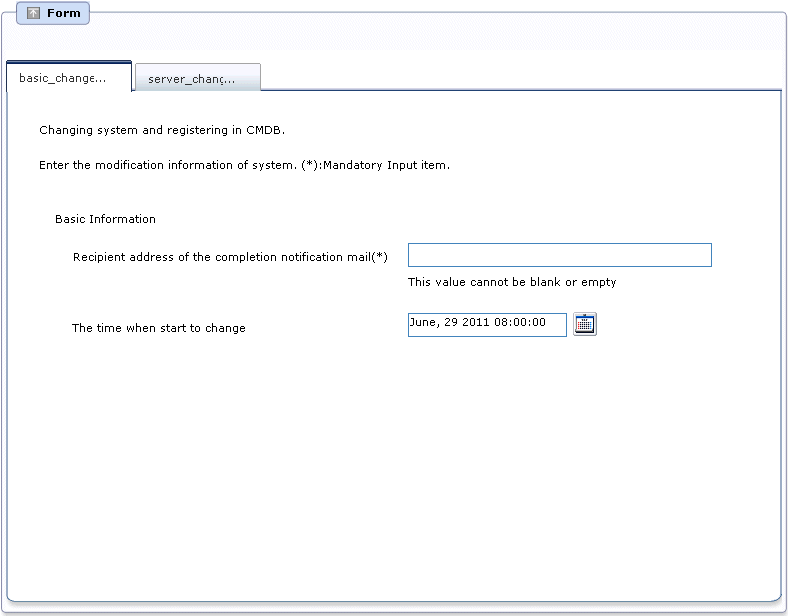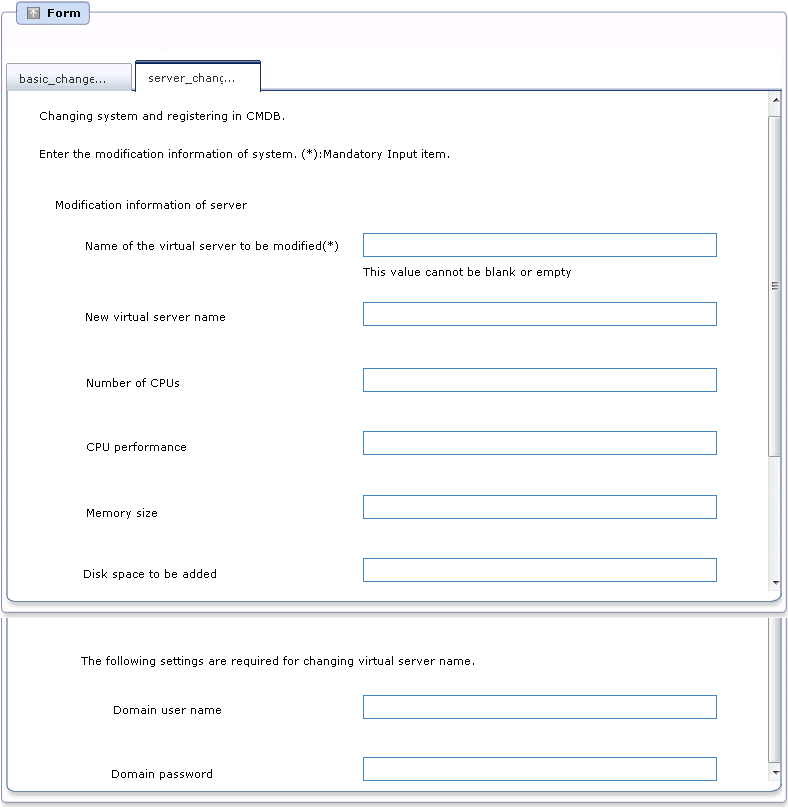This section explains the following Automated Operation Process items which are registered in CMDB after the systems provided in the virtual environment operations template are changed.
Processing overview
Changing the input values set in the Automated Operation Process
Information entered in the window
In the Automated Operation Process used for changing systems and registering them in CMDB, operations are processed in the following order.
The system change is authorized.
There is a wait until the specified time is reached.
The virtual server is stopped.
The virtual server system is changed.
The virtual server is started.
A check is made to ensure that the virtual server has started.
The virtual server information is registered in CMDB.
The virtual server host name is changed.
The virtual server is restarted.
A check is made to ensure that the virtual server has started.
A check is made to ensure that the virtual server is running normally.
The completion notification email is sent.


The operation components shown below are deployed to the Automated Operation Process.
Name | Name of operation component used | Objective |
|---|---|---|
Stop virtual server | Stop virtual server | Stop the virtual server. |
Change virtual server system | Change virtual server system | Change the virtual server system. |
Get virtual server details | Get detailed virtual server information | Get the virtual server details. |
Start virtual server | Start virtual server | Start the virtual server. |
Check operating status of node 1-2 | Check operational status of node | Check that virtual server has started. |
Register logical node | Register logical node | Register the information about the virtual server that was built in CMDB. |
Change host name | Change host name | Change the virtual server host name. |
Restart virtual server | Restart virtual server | Restart the virtual server. |
Confirm server running normally | Check server running normally | Check that the virtual server service is running, and check the port connection. |
Completion notification | Send emails | Notify the completion of the change to the virtual server system. |
Error notification 1-4 | Send emails | Notify that an error has occurred in the changing of the virtual server system. |
The following Automated Operation Process settings are required.
User defined attributes
Operation component input information
User defined attributes
The following values must be set for the Automated Operation Process user defined attributes. Enter the value according to the content shown below.
User defined attribute name | Input Value | Usage |
|---|---|---|
smtp_server | Host name or IP address of the (SMTP) server sending emails | Used as the hostname parameter value of the operation component that sends the email |
from_address | Error email sender's address | Used as the fromaddress parameter value of the operation component that sends the email |
Operation component input information
If necessary, set a value in the parameter for the following operation component input information that is deployed to the Automated Operation Process.
Completion notification
Error notification 1-4
Enter the parameter value according to the content shown below.
Operation component name | Parameter name | Input Value |
|---|---|---|
Completion notification Error notification 1-4 | smtpusername (Note 1) | User name of the user that executes SMTP authentication to the host of the (SMTP) server sending emails |
smtppassword (Note 1) | Password of the user that executes SMTP authentication to the host of the (SMTP) server sending emails |
Note 1:
Set this for an environment in which SMTP server authentication is required when the email is sent.
See
Refer to the Systemwalker Runbook Automation Studio User's Guide for information on how to change the Automated Operation Process.
At the time of the operation that uses the Automated Operation Process, enter the values required for the operation in the following windows.
Enter the modification information window
Enter these values when the Automated Operation Process is executed. This window is comprised of the following windows.
The setting window of Basic Information
The setting window of Modification information of server
Information entered in the Enter the modification information window (Basic Information)

Enter the following information in the Enter the modification information window (Basic Information).
Input Item | Requirement | Input content | User defined attribute of the Automated Operation Process which defines the input value |
|---|---|---|---|
Time at which the change will start | Optional | Specifies the time at which the change to the system will start in the format "YYYY/MM/DD hh:mm:ss". YYYY: Specifies the year in 4-digit format. MM: Specifies the month in 2-digit format. DD: Specifies the date in 2-digit format. hh: Specifies the hours in 2-digit format. mm: Specifies the minutes in 2-digit format. ss: Specifies the seconds in 2-digit format. The date and time that was set for the 'starttime' user defined attribute will be displayed as the default. The date can be entered using a calendar. | starttime |
Completion notification mail recipient address | Required | Specifies the completion notification email and error notification email recipient address. | toaddress |
Information entered in the Enter the modification information window (Modification information of server)

Enter the following information in the Enter the modification information window (Modification information of server)
Input Item | Requirement | Input content | User defined attribute of the Automated Operation Process which defines the input value |
|---|---|---|---|
Name of modified virtual server | Required | Specifies the name of the virtual server that will be modified. | servername |
Name of new virtual server | Optional | If the virtual server name is changed, specifies the virtual server name after this change is made. | newservername |
CPU number | Optional | If the CPU number is changed, specifies the CPU number after this change is made. | numofprocessor |
CPU performance | Optional | If the CPU performance is changed, specifies the CPU performance after this change is made. The GHz unit can be specified in the range from 0.1 to 8 (but only up to one decimal place). Note that you do not have to specify the unit (GHz) itself. | processorspeed |
Memory size | Optional | If the memory size is changed, specifies the memory size after this change is made. The GByte unit can be specified in the range from 0.1 to 255 (but only up to one decimal place). Note that you do not have to specify the unit (GByte) itself. | memorysize |
Added disk space | Optional | Specifies the additional disk size, when increasing the number of disks. The GByte unit can be specified in the range from 0.1 to 2048 (but only up to one decimal place). Note that you do not have to specify the unit (GByte) itself. | additionaldisksize |
Domain user name | Optional | Specifies the name of the user that connects to the domain, when the virtual server name is changed and the virtual server participates in the domain. | domainusername |
Domain password | Optional | Specifies the password of the user that connects to the domain, when the virtual server name is changed and the virtual server participates in the domain. | domainpassword |
Registering information in CMDB
After changing virtual server, the command has been executed to register changed server information in CMDB. If you create new automated operation process with using this template, do not delete the following operation components and node.
Obtain detail information (Operation components: "Get detailed virtual server information")
IP address and OS type which needed for executing command to register information in CMDB.
Start virtual server (Operation components : "Start virtual server")
It is necessary to start virtual server to collect information registered in CMDB.
Register logical node (Operation component: "Register logical node")
Register the updated information about the virtual server in CMDB.